Peter Hayes
Nautilus Institute
Forthcoming NAPSNet Special Report
November 2014
In 1978, Bryan Jack and a team of analysts at Pan Heuristics asked how nuclear weapons might be used to blunt a North Korean all-out attack on the South?[i] Their analysis (which posited South Korean nuclear weapons, but the results are identical if American nuclear weapons are substituted) still pertains today because nothing has changed with regard to the effects of nuclear weapons; and the disposition of forward-deployed North Korean forces along the DMZ is also largely unchanged.
It is therefore useful to revisit this analysis to ascertain how many nuclear weapons might be used today to stop a southward North Korean all-out attack; how such use might be designed for maximum effect; and how it compares with conventional weapons capacities to achieve the same effects, ultimately, halting the postulated North Korean attack.
To prefigure the conclusion, roughly 120 40 KT nuclear weapons would be fired in the three attack corridors, in broader areas north of these corridors, and at point targets such as hardened airfields, to block an all-out North Korean attack. Pan Heuristics concluded in 1978 that the same military effect could be achieved as or more efficiently with conventional artillery and bombs than using nuclear weapons. The same conclusion must be reached today, only more so due to the greatly increased precision and lethality of US-ROK conventional forces.
Only in the case of attacking the North’s cities were nuclear weapons more “efficient” because it was improbable that conventional forces could reach that far northward to match the speed and scale of counter-city nuclear attacks at the outset of a conflict.
Losing Seoul Nuclear Counter-Force Nuclear Attack Scenario
A typical attack corridor leading from the DPRK to the ROK averages less than 1.5 km wide, and narrows to ½ km wide defiles in places. At 20 km2 per attacking North Korean division, a 30 km attack corridor provides 45 km2 or enough for about 2 ¼ divisions at most. Assuming these forces move southward at 10 km per day, they could move ¾ of a division per day through the corridor. The nuclear attack imperative ostensibly arises from the assumption that this rate is faster than the US-ROK forces can muster reinforcements, thereby creating a demand for nuclear attrition, in say the Kaesong-Munsan approach. Because this corridor leads directly to Seoul, the ROK’s political and economic center of gravity, this “losing Seoul” scenario represents the most urgent case for the necessity of using nuclear weapons in war-time.
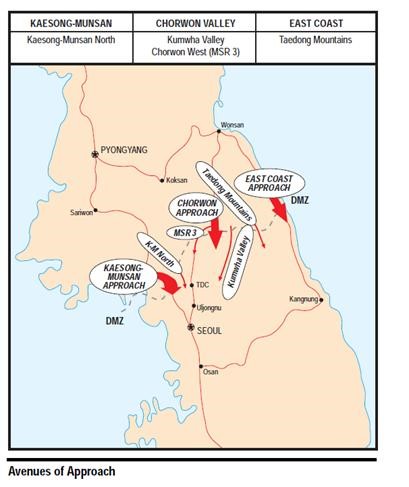 Source: Marine Corps Intelligence Activity, North Korea Country Handbook, May 1997, p. 52, released under USFOIA request to Nautilus https://nautilus.org/wp-content/uploads/2011/12/MarinesDPRKCountryHandbook.pdf
Source: Marine Corps Intelligence Activity, North Korea Country Handbook, May 1997, p. 52, released under USFOIA request to Nautilus https://nautilus.org/wp-content/uploads/2011/12/MarinesDPRKCountryHandbook.pdf
According to the Pan Heuristics report, there are three possible ways to conduct such a counter-attack. The first approach is to hit the south end of the invading North Korean force with a nuclear blast—thereby creating a gigantic bottleneck and gridlock north of the resulting mayhem. Such an attack would attempt to stun North Korean forces into halting and perhaps fleeing. North Korean soldiers are trained to lie down, take cover, and then resume the attack if they are attacked with nuclear weapons.[ii] But no-one knows if they would do so because no-one has ever used nuclear weapons on the battlefield before. One airburst nuclear detonation could suffice for simple immobilization. If desired, this single weapon could be burst at ground level, thereby creating a barrier of radioactive debris and fallout which would block any troops coming south (if they did so, they could only fight for a few hours before succumbing to radiation illness, or have to wait for a few days before passing to resume the battle, thereby losing the initiative).
Source: Army Forces Special Weapons Project, Radiological Defense, Volume 2, 1951, p.82, at: https://ia600801.us.archive.org/10/items/DnaEm1CapabilitiesOfNuclearWeapons/DnaEm1CapabilitiesOfNuclearWeapons.pdf
A second approach aims to destroy a substantial fraction of the attacking force in the corridor. The effective radius and lethal area of a nuclear weapon varies by mega-tonnage and (scaled) height of burst, but a 40 kilotonne (hereafter, KT, of TNT equivalent) weapon has a 2 km effective radius with a 12 km2 lethal area, enough to destroy about a third of a division in a 1.5 km corridor. (If the corridor narrows to only ½ km at the point of attack, assuming constant density of the attacking division, then the destruction falls to about 10 percent of a division). Thus, saturating the entire 30 km corridor to destroy all North Korean forces would take about eight 40 KT devices detonating about 3 km apart (the exact height, resulting effective detonation radius, and exact number of weapons required would be calculated by weapons targeteers to generate the drag loading and peak overpressure required to disable armored vehicles, and may vary from these round numbers).[iii]
Pan Heuristics notes that concentrated and sustained bombing or ROK artillery fire could achieve a similar or even greater devastation on a North Korean attack force. They calculate that 1375 F4 sorties dropping four 1 tonne bombs would achieve 90 percent attrition and match the destructive impact of one 20 KT nuclear attack in a 1.5 km wide corridor. About 110,000 artillery shells, or about 240 guns firing a round per 3 minutes for 24 hours could also achieve a 90 percent attrition rate matching a 20 KT nuclear weapon. (The ROK had 2000 105, 155, 175, and 205 mm guns in the late 1970s). This number of artillery shells could be reduced by ¾ if cluster munitions were used (the cluster munitions then in use covered 8000 m2 versus 2000 m2 for a standard bomb).
Pan Heuristics found that these 2000 tubes had the daily ability to match thirty 20 KT nuclear weapons, and perhaps exceed them by several times if cluster munitions were used. In comparison, the entire ROK air force at the 1970s could only deliver about one 20 KT worth of munitions. Therefore, focusing aerial bombardment on high value targets such as tanks and other armored vehicles in narrow defiles while allowing ROK artillery to conduct broad area attacks aimed at infantry appears to be a potent combination.
Destroying North Korean military vehicles such as armored personnel carriers and tanks is a necessary condition to halt the attack. A North Korean armored division fielded about 300 tanks in the late seventies, or about 15 per km2. The tank armor reduces the effective radius of nuclear attack by about half. A 40 KT nuclear weapon with an effective radius of 1 km will destroy about 47 tanks. Fifty two laser-guided conventional one ton (2000 pound) bombs delivered by F-4 or F-5 attack aircraft, or 16 sorties by specialized A-10 attack aircraft with 3 tank kills per sortie, could, in a day, match a 40 KT weapon if the tanks were in a confined area. If the tanks were distributed more widely, the aircraft would be more effective than a nuclear weapon in destroying tanks.
The third approach would be to attack behind the vanguard of the attacking force, enabling US-ROK forces to attrite the southward segment of North Korean forces cut off from the rest of the North Korean column by a nuclear blast, or two.
A division that is attacking southwards necessarily runs the gauntlet of US-ROK nuclear and conventional attack. A rear-based and bivouacked division must be dispersed over a 100 km2 area to avoid dangerous exposure. A 40 KT blast would cover about 12 km2, resulting in a 12 percent casualty rate for a division. Thus, at least nine or ten 40 KT nuclear weapons would be needed to attack one rear-based division, depending on its distribution. Similarly, it will be hard to disable logistic dumps and other supporting infrastructure, partly because much is widely dispersed, and much of it is underground. Thus upwards of 20 nuclear weapons at minimum would be needed to destroy one North Korean division. The DPRK has 20 divisions.
In wartime, the DPRK will need to move forward additional divisions to follow the vanguard force. The logistical and resupply transport infrastructure could be disabled by about four 10-40 KT nuclear blasts over the Pyongsan-Kaesong railway center, and those from Sepo and Sariwon connecting Pyongsan to Wonsan and Pyongyang respectively. Similar to attacking tanks, it is likely to be far more efficient to use precision-guided munitions against targets such as bridges, warehouses, or command centers. Moreover, any nuclear attack not in direct defense of Seoul is far more likely to bring China into the war.
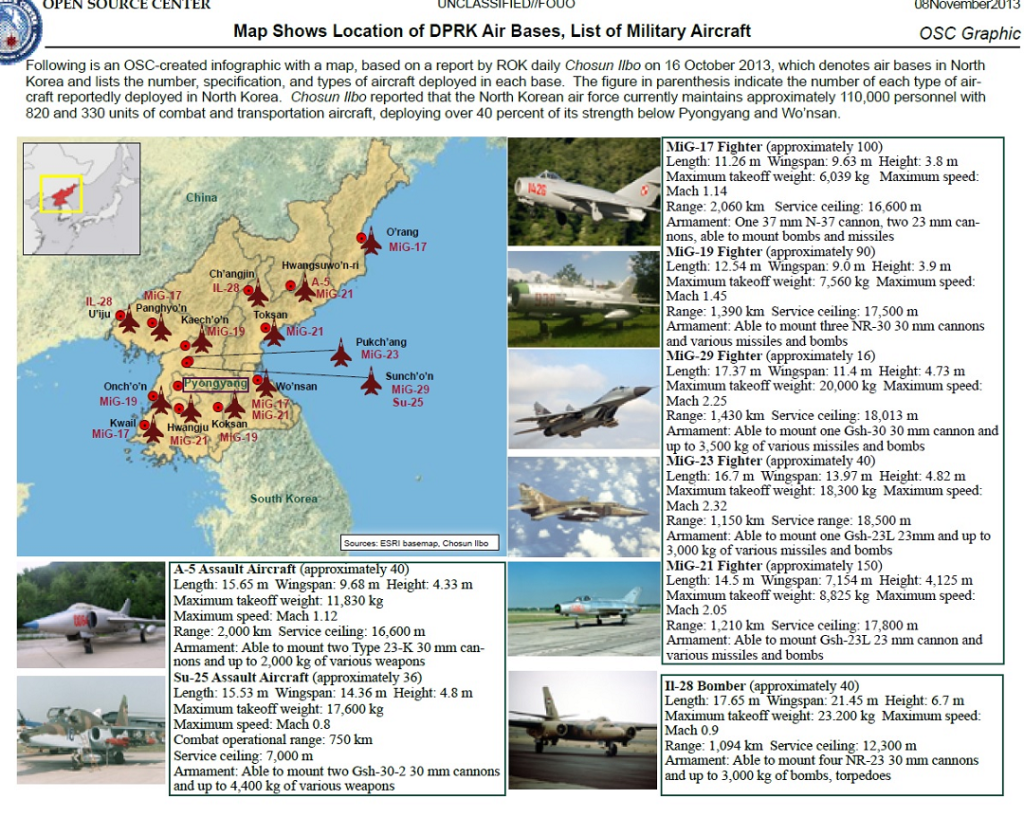 The DPRK has about 14 airfields with bombers stationed in northern DPRK; MIG 21s in middle airfields; and short-range aircraft near the DMZ. These have shelters and underground control centers; in one case (Magic Mountain near Pyongyang), the runway itself is largely underground. Hardened aircraft shelters are point targets. Jack estimates that five 40 KT nuclear warheads delivered with ½ km accuracy (by aircraft) and 80 percent delivery probability would give a 90 percent probability of destroying one 50 psi hardness aircraft hangerette cluster. To attack ten such clusters (two each in five airfields) therefore requires 50 nuclear weapons. Assuming nuclear weapons are delivered accurately, bomber pilots might be able to reduce the number by damage assessment before delivering all five warheads on a given target. About 24 aircraft would be needed to fly deep into North Korean airspace, much of which is heavily defended, to deliver such an attack in what would likely be one set of strikes.
The DPRK has about 14 airfields with bombers stationed in northern DPRK; MIG 21s in middle airfields; and short-range aircraft near the DMZ. These have shelters and underground control centers; in one case (Magic Mountain near Pyongyang), the runway itself is largely underground. Hardened aircraft shelters are point targets. Jack estimates that five 40 KT nuclear warheads delivered with ½ km accuracy (by aircraft) and 80 percent delivery probability would give a 90 percent probability of destroying one 50 psi hardness aircraft hangerette cluster. To attack ten such clusters (two each in five airfields) therefore requires 50 nuclear weapons. Assuming nuclear weapons are delivered accurately, bomber pilots might be able to reduce the number by damage assessment before delivering all five warheads on a given target. About 24 aircraft would be needed to fly deep into North Korean airspace, much of which is heavily defended, to deliver such an attack in what would likely be one set of strikes.
Thus, in the seventies, conventional bombs, even precision-guided bombs, might have taken many more sorties and longer to disable hardened sites at these airfields, relative to the required aircraft effort for nuclear attack. We have not made an estimate of the relative efficacy and plausibility of such a conventional attack on DPRK targets behind the front lines, except to note that today, this attack likely would be delivered by cruise missiles with far more robust C4ISR system to direct them and may well have tipped the balance towards conventional and away from nuclear weapons in achieving complete and absolute aerial dominance in the first few days of war with North Korea.
Counter-City Nuclear Attack Scenario
Although Americans and South Koreans don’t like to talk about it, one of the options countenanced in the seventies for nuclear weapons was to retaliate for the loss of Seoul by attacking North Korean cities.
Assuming an all-out counter-value attack on North Korea’s six major cities at that time, namely, Pyongyang, Hamhung, Chongjin, Kimchaek, Wonsan, and Sinuiji, one 40 KT nuclear blast on each, would have killed 650,000-1 million mostly civilian North Koreans, or about 7 percent of the then 16 million total North Korean population. This figure might fall if the DPRK were already on alert with many city-dwellers dispersed or in deep underground shelters. South Korea’s population is far more urbanized and concentrated with the Seoul-Inchon metropolis now representing about 48 percent of South Korea’s population. This fraction of the DPRK’s population would be much smaller than the fraction that might be lost to the ROK if Seoul were occupied and held by the DPRK, or if Seoul had been attacked by one of the DPRK’s allies with a nuclear weapon in retaliation for American first use in the DPRK. Unlike the counter-force reach of ROK conventional weapons, the counter-city impact could not be achieved by the ROK with conventional weapons at distance. Thus, it is only for counter-city attacks that nuclear weapons have a relative advantage over conventional weapons. The political and moral logic of such an attack was dubious even in the nineteen seventies, let alone in 2014.
Conclusion
Overall, therefore, it would take about 120 40 KT nuclear blasts to destroy the vanguard and 2nd echelon six divisions attacking via the 3 attack corridors over the DMZ, along with crippling the logistical infrastructure and airfields that would support these attacking forces. This result can be achieved with conventional artillery and aircraft, however, in some cases more efficiently and precisely than with nuclear blasts – and with far lower probability of drawing a nuclear attack in the process.
_____________________________________________________________________________Nuclear Attack Options Against the DPRK
_____________________________________________________________________________
- Destroy one division attacking Seoul via attack corridor
- Bottleneck at south, before reach DMZ: 1-2 40 KT
- Destroy division in 30 km long invasion corridor: 8 * 40 KT
- Cut off vanguard, gain time: 1-4 KT
- Destroy rear-based division and supporting logistics
- Area attack, 20 * 40 KT per division * (17 divisions, 3/20 are forward and attacking); assume attack 3 2nd echelon divisions only = 60
- Disable 4 railway centers 4 * 40 KT
- Destroy 5 forward and middle airfields: 50 * 40 KT
Total counterforce: (1 to 8) + 60 + 4 + 50 = (115 to 122) * 40 KT
- Destroy 6 cities, kill 7 percent most civilian population: 6 * 40KT
It would take only a few—perhaps one, or perhaps as many as six, 40 KT nuclear warheads to damage North Korea’s urban population to the extent that it might cripple North Korean society and force it to either halt its attack or to abandon an already achieved occupation of Seoul. Only nuclear weapons offer a counter-city option at the start or shortly after the start of an all-out war with the DPRK.
The same logic more or less works in reverse. The DPRK could not hope to use its maybe 10 nuclear weapons to stop a US-ROK conventional attack except perhaps in one attack corridor, which would not suffice to stop a northward push by US-ROK forces. If and only if were already losing a war, or had already lost Pyongyang to US-ROK forces, would it potentially make sense for the DPRK to use or threaten to use nuclear weapon in a counter-city strike.
The plausibility of such a strike is dubious for either party. If the US-ROK were to attack North Korean cities with nuclear weapons at the outset of a war, it would be highly likely to bring China into the conflict, either with a nuclear riposte, or with massive conventional forces.
If the DPRK were to use a nuclear weapon to attack a ROK city, China could also enter the war, only this time, alongside US-ROK forces, and would help remove DPRK’s leaders from power. Whether the US can deter such an attack during a northward march in response to a DPRK conventional all-out attack by threatening nuclear retaliation is dubious. Indeed, such a threat might invoke a DPRK nuclear response. At most, a silent threat arising from the mere capacity to conduct such a strike, leaving it solely to the DPRK leadership’s imagination, would suffice to achieve whatever marginal deterrence might be achievable from nuclear threat in such a circumstance, even in the case of a DPRK explicit threat to conduct such a suicidal strike in the course of losing a conventional war.
Unlike Pan Heuristics’ calculations which were done on paper using calculators, today the reader can lay-down their own imagined nuclear attack on the DPRK at Nukemap,[iv] specifying the altitude of the nuclear detonation, the KT, the location, and how many nuclear attacks are detonated. Below is one such attack for the Kaesong corridor, for a 40 KT weapon, airburst at 0.6 mile altitude (to maximize the overpressure range effect). The ROK worst case—the wind blowing the resulting radioactive plume towards Seoul—is presented; the reader can vary the assumptions to suit).
Since the Pan Heuristics report was written, the lethality of precision-guided weapons has increased by at least 2 orders of magnitude. The relative ability of conventional weapons to the roughly similar capacity of nuclear weapons to destroy the similarly configured North Korean divisions has increased greatly. A conventional suppression campaign against the DPRK’s artillery and rocket forces is feasible using smart “sense and destroy” cannon rounds, GPS guidance technology, rapid target acquisition capacities, mining of the egress areas of pop-up hardened artillery sites, and detailed mapping of fixed sites.[v]
Thus, the real military problem is not defeating North Korean attacking forces with conventional or nuclear weapons. The latter is simply a fantastic notion.
The real problem is suppressing the counter-city conventional capacity of the DPRK to sledgehammer northern Seoul. As we showed in a separate analysis,[vi] this is a difficult problem still for US-ROK forces to solve; but nuclear weapons add nothing to this solution because the 260 odd point targets housing the DPRK’s long-range artillery and a similar number of multiple mobile rocket launchers are not suitable targets for nuclear attack. They are too dispersed; and located in an area too close to Seoul. The number of nuclear weapons required to destroy these hardened targets would number in the hundreds.
Thus, the only residual salient threat that can be exploited from US-ROK nuclear weapons is the counter-city threat—nuclear weapons used against North Korean cities in the first few days of a war to induce the DPRK to halt the artillery and rocket barrage of Seoul. This is such a disproportionate use of nuclear weapons as to be incredible. Moreover, it is precisely the use option that is most likely to induce North Korean counter-city retaliation using its own nuclear weapons, which would defeat the very purpose of US-ROK use.
In short, there are no credible use scenarios on which to base a nuclear deterrence threat in the Korean Peninsula that do not either exceed what conventional forces could achieve, possibly in a more efficient manner than nuclear weapons; or in a way that is not only counter-productive, but self-defeating.
Source: http://nuclearsecrecy.com/nukemap
[i] This analysis draws on pp. II-85 to II-93 of B. Jack et al, The South Korean Case: A Nuclear Weapons Program Embedded in an Environment of Great Power Concerns, volume II, Regional Rivalries and Nuclear Responses, Panheuristics Final Report to US Defense Nuclear Agency, DNA 001-77-C-0052, February 28, 1978, at: https://nautilus.org/foia-document/regional-rivalries-and-nuclear-responses-voluume-ii-the-south-korean-case-a-nuclear-weapons-program-embedded-in-an-environment-of-great-power-concerns/
[ii] See P. Hayes, Pacific Powderkeg, American Nuclear Dilemmas in Korea, Lexington Press, 1990, p. 127, at: https://nautilus.org/wp-content/uploads/2011/04/PacificPowderkegbyPeterHayes.pdf
[iii] The severe damage radius for a height of burst at about 2000 feet and a 40-50 KT is about 500 meters, depending on many factors. Aircraft are disabled by peak overpressure of 1-2 psi; locomotives were turned over at 5-6psi and cars completely demolished at 9psi. Severe damage to armored vehicles occurs at above 5 psi overpressure according to a number of studies. See
Samuel Glasstone and Philip J. Dolan eds, The Effects of Nuclear Weapons, 3rd edition, US Department of Defense and US ERDA, 1977, pp 192-193, at: http://www.fourmilab.ch/etexts/www/effects/
US Department of the Army, Staff Officers Field Manual Nuclear Weapons Employment, FM 101-31-1, February 1963, figure 2, p. 2.
Click to access DnaEm1CapabilitiesOfNuclearWeapons.pdf
- Halpin et al, Nuclear Weapons Effects on Army Tactical Systems, Harry Diamond Laboratories, report to US Army materiel Development and Readiness Command, April, 1979, p. 18, shows blast induced damage for wheeled vehicles begins at about 7 pounds psi static overpressure.
[iv] Found at: http://nuclearsecrecy.com/nukemap/
[v] A. Long, Deterrence—From Cold War to Long War, Lessons from Six Decades of RAND Research, RAND, Santa Monica, 2008, pp. 77-78, at: http://www.rand.org/pubs/monographs/MG636.html See also
[vi] Roger Cavazos, “Mind the Gap Between Rhetoric and Reality”, NAPSNet Special Reports, June 26, 2012, https://nautilus.org/napsnet/napsnet-special-reports/mind-the-gap-between-rhetoric-and-reality/


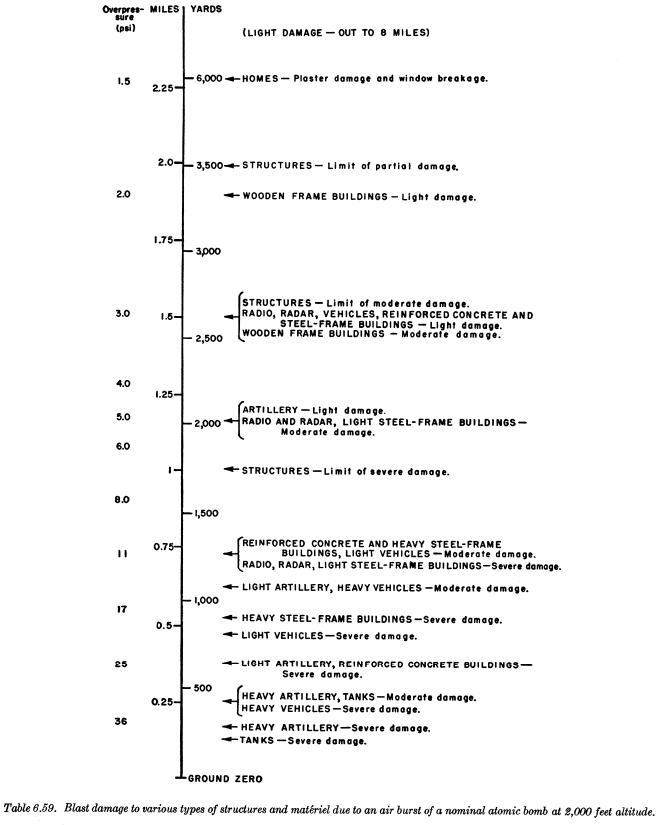
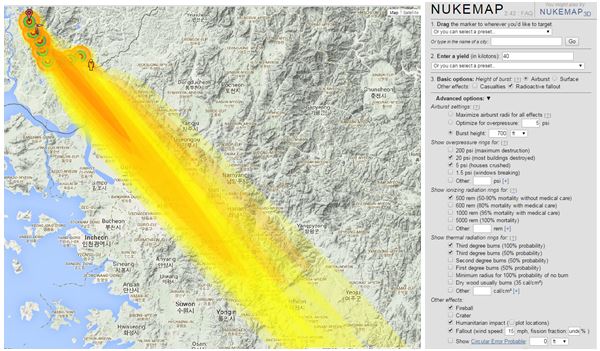
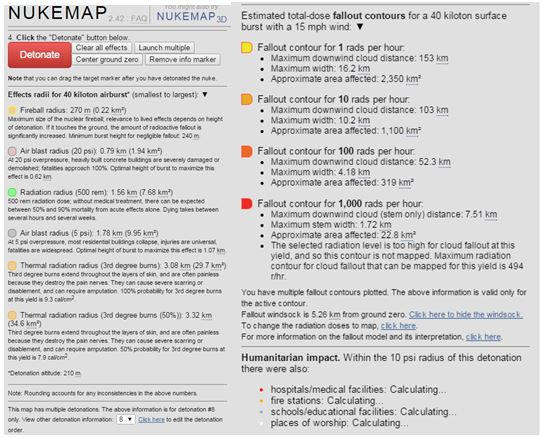
One thought on “Nuclear Warfighting to Defeat a DPRK Attack: Unnecessary, Disproportionate, Incredible, and Self-Defeating”